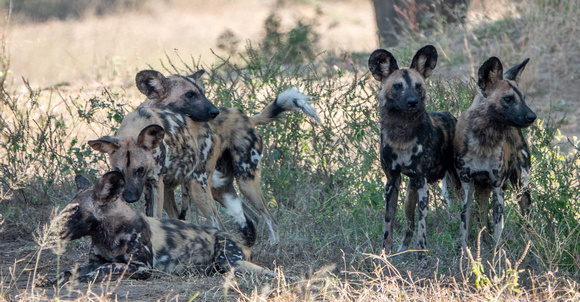African Wild Dogs (Lycaon pictus), Calm and Friendly
12:23:53 pm. From Wikipedia, July 2023: The African wild dog (Lycaon pictus), also known as the painted dog or Cape hunting dog, is a wild canine native to sub-Saharan Africa. It is the largest wild canine in Africa, and the only extant member of the genus Lycaon, which is distinguished from Canis by dentition highly specialised for a hypercarnivorous diet, and by a lack of dewclaws. It's estimated that there are around 6,600 adults (including 1,400 mature individuals) living in 39 subpopulations that are all threatened by habitat fragmentation, human persecution, and outbreaks of disease. As the largest subpopulation probably comprises fewer than 250 individuals, the African wild dog has been listed as endangered on the IUCN Red List since 1990.[2]
The species is a specialised diurnal hunter of ungulates, which it captures by using its stamina and cooperative hunting to exhaust them. Its natural competitors are lions and spotted hyenas: the former will kill the dogs where possible, whilst hyenas are frequent kleptoparasites.[4] The African wild dog possesses the most specialized adaptations among the canids for coat colour, diet, and for pursuing its prey through its cursorial (running) ability. It has a graceful skeleton, and the loss of the first digit on its forefeet increases its stride and speed. This adaptation allows it to pursue prey across open plains for long distances. The African wild dog exhibits one of the most varied coat colours among the mammals. Individuals differ in patterns and colours, indicating a diversity of the underlying genes. The purpose of these coat patterns may be an adaptation for communication, concealment, or temperature regulation. In 2019, a study indicated that the lycaon lineage diverged from Cuon and Canis 1.7 million years ago through this suite of adaptations, and these occurred at the same time as large ungulates (its prey) diversified.[19] Males and females have separate dominance hierarchies, with the latter usually being led by the oldest female. The dominant pair typically monopolises breeding. The species differs from most other social species in that males remain in the natal pack, while females disperse (a pattern also found in primates such as gorillas, chimpanzees, and red colobuses) [and some human societies -- DJQ]. ...breeding is strictly limited to the dominant female, which may kill the pups of subordinates. When separated from the pack, an African wild dog becomes depressed and can die as a result of broken heart syndrome. Because the African wild dog largely exists in fragmented, small populations, its existence is endangered. Inbreeding avoidance by mate selection is a characteristic of the species and has important potential consequences for population persistence.[58] Inbreeding is rare within natal packs. The African wild dog is a specialised pack hunter of common medium-sized antelopes.[60] It and the cheetah are the only primarily diurnal African large predators.[29] The African wild dog hunts by approaching prey silently, then chasing it in a pursuit clocking at up to 66 km/h (41 mph) for 10–60 minutes.[48] The average chase covers some 2 km (1.2 mi) Lions dominate African wild dogs and are a major source of mortality for both adults and pups.[73] Population densities are usually low in areas where lions are more abundant. The African wild dog is primarily threatened by habitat fragmentation, which results to human–wildlife conflict, transmission of infectious diseases and high mortality rates. There is much more to learn: google them!


